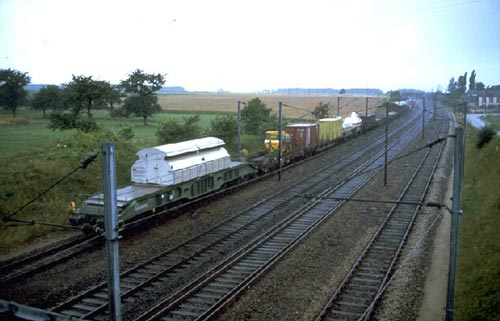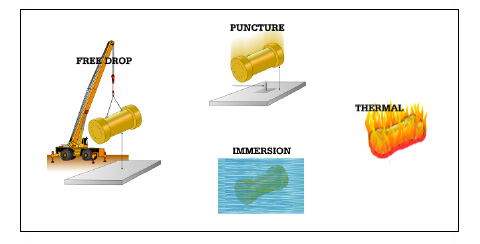Measures to ensure safe transport
Nuclear materials may be highly radioactive. The goal is to prevent any risk of an accident and ensure maximum safety. To achieve these goals, the principles of “defence in depth” are applied. Maximum safety is achieved through robust packages and casks, reliable transport and effective accident prevention measures.

Rail transport
This photo shows a cask containing irradiated fuel being transported by rail. The railway offers a very safe means of transport, and is the preferred option for carrying large or heavy packages whenever a rail link is available. As a result, almost all irradiated fuel assigned for reprocessing is carried by rail to the Valognes rail terminal near the plant in La Hague.
© SIDNEY JEZEQUEL /AREVA
Due to the radioactivity that it contains, irradiated fuel must be transported in specially-designed containers known as “casks”. In France, PWR fuel assemblies are transported in casks designed to hold 12 fuel assemblies, in a dry air atmosphere. Casks with similar specifications are used to carry MOX and vitrified waste. They have thick walls that protect against radiation and are sealed to prevent any dissemination of radioactive materials.
The transport cask forms a containment barrier, enabling fuel elements to be transported by road, rail or sea.

Drop and fire behaviour tests
Radioactive material transport casks are designed to withstand powerful shocks and resist fire, in order to prevent dispersion of their contents. The photograph on the left shows a test in which a mock-up of a TN24 transport cask is dropped from a height of 9 m. The image on the right shows a fire resistance test with an FS47 container and transport cask designed to carry plutonium. The tests were performed at the Morvilliers test centre in France.
© AREVA/Jean-Marie Taillat
These very strong steel containers weigh more than 100 tonnes and have walls up to 30 cm thick. Transport casks are designed to withstand fire, rocket strike or crushing, as might occur in the event of an accident involving the truck or train on which they were being carried. They are tested to assess their resistance to impacts (at 50 km/h), puncture, fire (exposure to an 800°C fire for 30 minutes) and immersion (200 m depth of water).
Rail, acknowledged to be a very safe means of transport for large convoys, is the preferred option for carrying large or heavy packages whenever a rail link is available.
Nuclear fuel is never transported by air, for obvious safety reasons.
Sea transport accounts for 3% of all movements of radioactive material relating to the nuclear fuel cycle.

Casks safety tests
To prevent any risk of dissemination of radioactive materials, transport casks must comply with very strict requirements stipulated by safety authorities. For example, in the United States, all transport casks must undergo free drop, puncture, immersion and fire resistance tests before being certified by the Nuclear Regulatory Commission.
© DOE
The ships used to carry MOX fuel to Japan are specially equipped with redundant features and systems, including a double hull, fire detection and extinguishing systems and anti-collision radars. The ship is accompanied by an armed escort, and its position is tracked in real-time by a satellite positioning system.
In the event of a shipwreck, the walls of transport casks and containers, as well as the zirconium alloy cladding (in the case of irradiated fuel) or the glass matrix (in the case of vitrified waste) would impede the dissemination of radioactive materials. If and when corrosion breaches the containers, after a few decades at the least, the uranium oxide fuel pellets and insoluble vitrified matrices would also resist dissemination. One remembers the tragic loss of the Kursk submarine, which was raised to the surface in October 2001. Contrary to many people’s fears, no radioactive leaks were detected, due to the relatively short time spent in the sea.
Other articles on the subject « Waste management »
Waste management status
Repositories already in operation for low-level waste Compared with other types of waste, the mas[...]
Other storage facilities
Interim waste storage according to their nature and origin Spent fuel and vitrified waste from Pr[...]
Temporary storage
A temporary solution Interim storage is a temporary solution that plays a central role in the man[...]
Vitrified waste Storage
Dry storage of vitrified waste Spent nuclear fuel assemblies are not the only materials removed f[...]
Spent fuel storage
Interim storage in pools and then dry locations In all countries, spent fuel management begins wi[...]
Management outside France
Overview of waste management strategies outside France Management of the least radioactive waste [...]
LILW-SL waste repository
Disposal of low and intermediate-level short-lived waste Low and intermediate-level short-lived w[...]
VLLW repository
An operational repository for very low-level waste The second category of waste for which a repos[...]
High level waste transportation
Moving highly radioactive materials The 10% of transport movements that concern high-level radioa[...]
Transport-related incidents
Incidents but no accidents… Have radioactive material transport operations caused any accid[...]